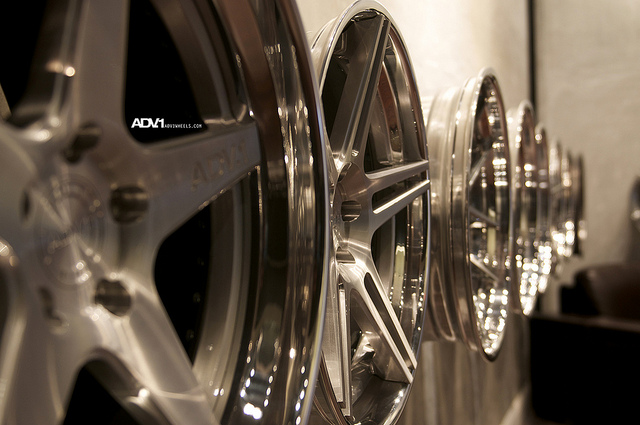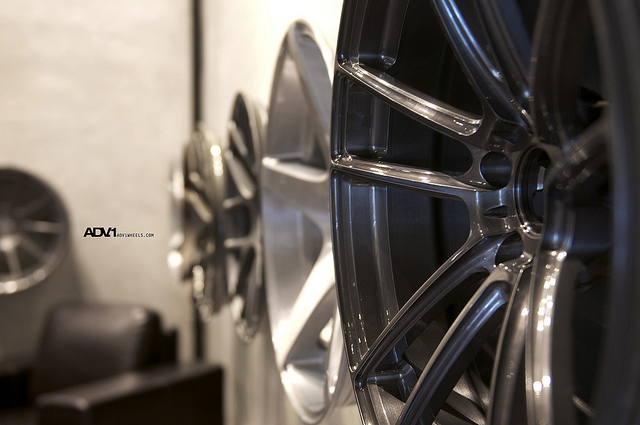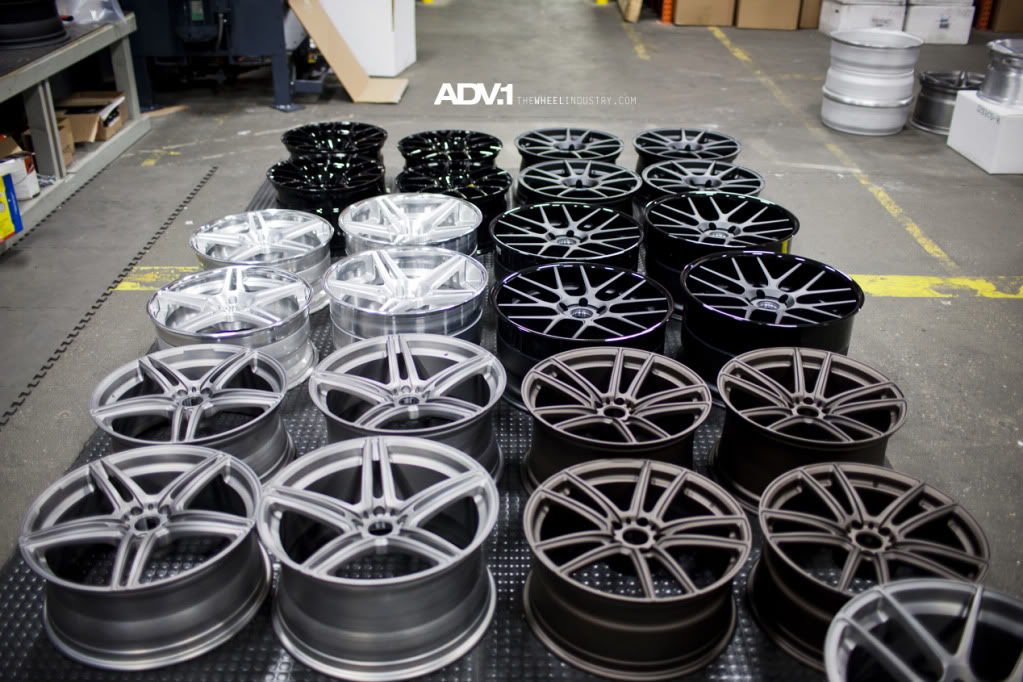We usually bring you articles about innovation and the growth of ADV1 but for once we decided to take a step back and create a basic educational guide to the wheel industry. Since ADV1 dominates the concave game and has been offering more wheel variations than we can think of, it only made sense for us to ask Jordan Swerdloff his take on the wheel industry basic.
What do the terms one, two, and three piece wheels mean?
These numbers describe the wheels construction. Despite what many people are told, the term 1, 2 or 3 piece wheel has nothing to do with the quality of the wheel itself. The construction of most aftermarket and OEM wheels normally consists of 1 of these 3 main categories; each has it’s own pro’s and con’s depending on the intended use of the wheel.
1 piece: Forged or cast aluminum “monoblock” consists of a single piece of aluminum or other material. Cast wheels are typically mass produced, inexpensive wheels made using a mold / casting process which basically produces large quantities of the same exact wheel per mold. It’s very efficient and mostly done overseas. The forged 1 piece wheel is another story, these are designed for lower volume and come at a much higher cost than cast wheels. However they are lighter, stronger and normally made specifically to order whether it be 1 set or 20 sets. It’s first engineered and produced as a die which is pressed into it’s basic shape or “blank forging”. This is engineered specifically based on the applications, use, and fitments the forging is intended for. The blanks are then “turned” which creates the wheels profile shape, individually engineered and programmed, and in many cases different from front to rear, order to order. Lastly, the CNC milling process machines out the design of the wheel.
2 piece wheels: The 2 piece construction is actually done in several ways, some manufacturers have designed their own versions of these for their own reasons. Some with the intent to create a lower priced wheel with a 3 piece look by issuing a 1 piece barrel and cast center. Some use a forged CNC milled center disc with a cast “barrel” and some use various combinations of these methods, mostly due to different ideas and trends over time which has left a wide range of methods for 2 piece wheel manufacturing and materials.
3 piece wheels: The 3 piece wheel uses 3 main components, making it modular which from a production and manufacturing stand point means, wider range of sizes and applications using less aluminum inventory due to the interchangeable parts. The center disc, or “face” of the wheel is combined with an outer barrel, or “lip” and an inner barrel. The 3 components are bolted together at the assembly flange which corresponds to all 3 parts. The 2 rim halves are then balanced with the center disc in place, then sealed with a silicone sealant before final tightening of the assembly fasteners.
What are the advantages and disadvantages of each?
For OEM use on new vehicles, a mass production cast 1 piece wheel is most efficient and profitable as these are made for high volume production, lower cost and longevity. Some manufacturers are now offering forged 1 piece wheel options on some higher end vehicles mainly as a result of new manufacturing technology making it more efficient and cost effective to produce in semi-high production volume. The 1 piece forged wheel provides the end user with a typically more conservative look than a 3 piece which for some is a good thing, others not such a good thing. Performance wise, the 1 piece doesn’t necessarily have any advantage over a similar size / style / quality 3 piece wheel.
Although a common misconception is often heard regarding 3 piece wheels where a well built wheel, assembled by a professional using the correct equipment, parts and materials should provide the same exact reliability and performance of a 1 piece wheel. With that being said, unfortunately this is not always the circumstance and as a result, many 3 piece wheels are improperly assembled, use inferior parts and are not controlled in terms of rebuilding, refinishing, and component quality.
Without getting into too much detail on the pros and cons of each, here are the key features of the 3 wheel types. I wouldn’t say that any of them have advantages over the other overall, instead each has different features which may be positive or negative depending on the users personal preference, intended use, and budget.
1 piece cast:
Biggest advantage would be a lower cost. Generally heavier than a similar forged alternative in some cases, typically not made to order meaning a more generic fitment in some cases with little or no options. Used on most OEM vehicles due to low production costs and high volumes.
1 piece forged:
Biggest advantage is that it often provides an OEM look with improved performance, lighter weight, aggressive offsets and sizes, individually ordered finishes in many cases and overall reliability. Depending on the manufacturer these can be ordered either completely custom tailored or from a standardized selection of options. In order to provide a wide range of sizes and profiles, a large amount of forging inventory must be maintained which in most cases is not realistic for many manufactures. Because of this, a disadvantage is more seen on the production side. From the end users perspective, price and availability may be the only downfall to a forged 1 piece wheel if aesthetically it’s the preferred wheel type.
2 piece:
Generally, a 2 piece is offered at a lower price point than a 3 piece or forged 1 piece however a higher price than a cast 1 piece wheel. It offers more versatility from a manufacturers standpoint vs a 1 piece forged or cast wheel equating to less inventory requirements in most cases, and lower production costs. I personally would describe the current 2 piece offerings seen today as a good upgrade from a cast 1 piece wheel and a lower quality, less expensive alternative to a forged 1 or 3 piece wheel. I’m sure as time goes on more developments and products will come and go using 2 piece construction, there’s lot’s of potential advantages for them for both production and to the end user.
What are the available finishes for custom wheels?
Every manufacturer offers their own selection of finishes. Most stick to the popular trends such as brushed aluminum, gloss or matte blacks, chrome, etc. Finishing varies a lot between brands as trends and styles are heavily based on the market the brand caters to. Some specialize in bright colors, multi stage combinations, chrome, etc. While others may be more conservative, mainly sticking to the basics such as silver, polished, OEM PPG color matches, etc. I make it a point not to try and copy the finishes that other brands may have branded as their own. I stick to only the finishes that I personally would like to have on my own wheels, based on my own personal taste and not on the current trends. For the most part, a custom wheel is exactly that, custom. It’s up to the customer as to how they would like the wheel finished, some brands will cater to their requests, some will not, however most are capable of producing any request a customer may have.
How are finishes applied? What are the pros and cons of each finish?
For the most part, custom finishes are applied using either liquid paint or powder coat for their non metallic (chrome, polished, etc.) type finishes.
I’m sure their are many pros and cons to each, however the typical wheel manufacturer will explain from experience that a powder coat finish will provide a strong, long lasting finish. A liquid paint is also strong and lasts equally as long when properly applied however more prone to the usual rock chips and scratches vs a powder coat. On the up side, a liquid paint can provide, if applied properly, a show quality, deep, automotive paint style look to any wheel in nearly any color combination. It’s mixed by hand and can be applied in any style or finish imaginable. To summarize, powder coat provides excellent quality, strength and longevity. Liquid paint provides the exotic combinations, glass like shine, or precise PPG color matching tones if the order calls for something like this. They each have their strong points however in most cases, at least with our wheels we use about 80% powder coat mainly because we focus on long term use and a classic, minimal style which can be achieved using high quality powder coatings and specifically formulated blends we’ve developed over time.
What are the common terms in custom wheels that our readers would need to be familiar with?
That’s a good question, I sometimes forget to speak in non wheel industry terminology when speaking to clients. There’s almost an entire language spoken and understood by only the few on this end of the wheel industry. Sometimes I’ll be speaking to my head engineer, Tom and I don’t even know where we came up with the terms used to describe the different features and engineering nicknames with some of our wheels. I realized this recently when in an email to some of the guys I wrote “TV1000, this one is gonna use SL aesthetics, Claunch it though and leg extensions on the rears only for the deep spec’ness and in front drop the et a little bit by adding some CDP not pad height so we can get the 2.5 at least. Use the U-forging with a mini leg if needed” Seriously, what does that mean? To us it’s just a normal email but to others, even staff it’s completely foreign.
Anyways, for the end user who wants to be able to understand this a little better it’s good to understand the basics like:
Monoblock: usually refers to a 1 piece forged wheel barrel: many call the inner / outer rim halves of a 3 piece wheel, the “barrel” which I personally don’t recommend but it’ll do for most conversations.
Lip: the 3 piece outer rim half, commonly referred to as the lip. Many use the lip size in inches as a way to describe the look of the wheel, for example, “I want a 6 inch lip on my c class” lol.
Step lip: pretty self explanatory, actually maybe not – the step lip is another version of the 3 piece outer rim half, it uses a stepped profile which allows for additional strength, reduced water retention and lighter weight vs a normal flat lip or, “reverse” lip counterpart.
CDP: we made this one up, it means concave depth pressure! Just a funny term we like to use to describe the deepness of the concave profile. Since this is something new to the aftermarket wheel brands, we had to make our own dictionary. Wikipedia doesn’t approve unfortunately : (
Winbutter: another ADV.1 exclusive, doesn’t really mean anything though.
What should they look for when selecting a custom wheel manufacturer?
Basically, if it’s got the letters ADV.1 on it you’re good! Lol I’m just kidding guys, this is actually a very serious question. Obviously I have a biased opinion on this, however all that aside, my unbiased, genuinely honest as humanly possible advice based on experience and knowledge learned from my own mistakes over the years is first and foremost you must prioritize safety. Bottom line, there’s no regulation in the US for wheel manufacturing, materials, testing, assembly, finishes, etc. Not only your own safety is at stake, but the safety of your passengers and others around you. Knowing what I know now, seeing what I’ve seen over the years I’ve learned the importance of this. Before selecting a wheel, regardless of price, style, 1 piece, 3 piece, 100 piece, make sure you’re buying a safe product. Unfortunately there’s no seal of approval to look for, no certificate of safety anyone can show you. If considering a brand of wheels, regardless of where you plan to purchase them, regardless of what anyone else tells you, first call the manufacturer and speak to someone who can educate you on their engineering and testing procedures. Any responsible manufacturer should have no problem either giving you the information you need or having someone get back to you with answers to your questions and hopefully even some test data to back their information up. Besides that, in this business there’s only one way to be successful and it’s by providing a quality product and service. A company that has even a few years of history behind them and is still going strong today says a lot more than you’d imagine.
Aside from the safety patrol, and aside from the obvious such as style, marketing, naked chicks, dudes or whatever attracted you to that company – none of it means anything without post sale support and service. Custom wheels can’t be replaced at the dealer, they require hands on service from the manufacturer in order to provide you with any repairs, warranty issue resolution, refinishing, etc. It costs thousands of dollars to support hundreds of customers down the road and only the strong, successful companies can truly provide this kind of service. Read the warranty terms & conditions, maybe even make a test call or email just to make sure they’re prepared to properly service any customer in need of support. Lastly, after all that… make sure you love them, they’re expensive and you shouldn’t settle for anything less than your dream wheel.
Do you get what you pay for? Does a custom 3 piece wheel justify the price tag? Why?
This is a tough one from my side of the business to be honest. ADV.1 Wheels, although some of which are priced at the higher end of the spectrum, those same wheels may actually be twice the production cost of the closest competing wheel, if not more. At the same time, our lowest priced forged wheels, the Trak Function and S-Function lines use the same quality parts and construction as all of our other wheels, yet aesthetically they fall under the same category in terms of forging style as the highest priced competitors wheel options. So, do I think you get what you pay for?
To answer this question, at least as accurately as possible from an outside perspective I would have to say that it all depends. What’s important to one may not be as important to another and what price tag is justifiable to one may not be to another. I’ve learned over time that some customers prefer to pay top dollar, so long as the service justifies it and some demand that we provide them with wheels at half price, delivered in under a week, plated in gold and installed by a team of choir boys in order to satisfy them. Everyone’s different, some want a deal and some want quality and service, most want both.
Overall, the days of the no name brand $10k 3 piece wheels are over due to saturation, competition, and of course the real estate bubble nuclear meltdown. Most of the pop up brands have faded away by now leaving only the stronger, established names still in business today. Besides us of course : ) Although newer than most, we went through the worst of it and we’re still here. Now, prices are realistic and consumers are more educated it seems. A high price tag can only be so if it’s justifiable, otherwise it wouldn’t be high or they wouldn’t be around. The lower price tags are low because they have to be for whatever reason, image, quality, production, whatever the case may be it’s priced accordingly in today’s wheel industry. Do you get what you pay for? I think if you paid a fair priced based on MSRP then in most cases yes. Does a custom 3 piece wheel justify the price tag? It all depends on, guess who? The customer.






